2008 CHEVROLET HHR control panel
[x] Cancel search: control panelPage 252 of 430
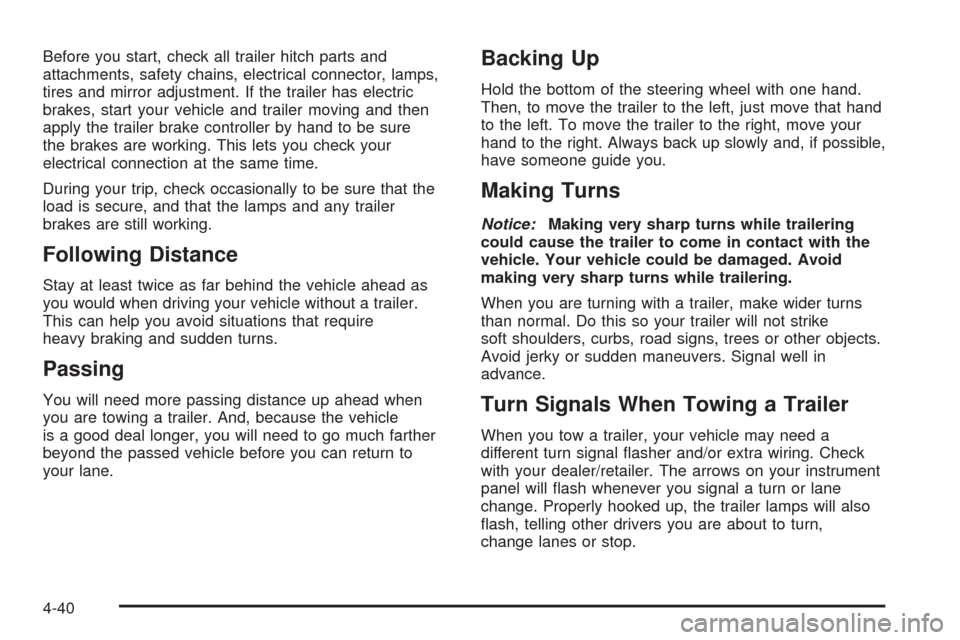
Before you start, check all trailer hitch parts and
attachments, safety chains, electrical connector, lamps,
tires and mirror adjustment. If the trailer has electric
brakes, start your vehicle and trailer moving and then
apply the trailer brake controller by hand to be sure
the brakes are working. This lets you check your
electrical connection at the same time.
During your trip, check occasionally to be sure that the
load is secure, and that the lamps and any trailer
brakes are still working.
Following Distance
Stay at least twice as far behind the vehicle ahead as
you would when driving your vehicle without a trailer.
This can help you avoid situations that require
heavy braking and sudden turns.
Passing
You will need more passing distance up ahead when
you are towing a trailer. And, because the vehicle
is a good deal longer, you will need to go much farther
beyond the passed vehicle before you can return to
your lane.
Backing Up
Hold the bottom of the steering wheel with one hand.
Then, to move the trailer to the left, just move that hand
to the left. To move the trailer to the right, move your
hand to the right. Always back up slowly and, if possible,
have someone guide you.
Making Turns
Notice:Making very sharp turns while trailering
could cause the trailer to come in contact with the
vehicle. Your vehicle could be damaged. Avoid
making very sharp turns while trailering.
When you are turning with a trailer, make wider turns
than normal. Do this so your trailer will not strike
soft shoulders, curbs, road signs, trees or other objects.
Avoid jerky or sudden maneuvers. Signal well in
advance.
Turn Signals When Towing a Trailer
When you tow a trailer, your vehicle may need a
different turn signal �asher and/or extra wiring. Check
with your dealer/retailer. The arrows on your instrument
panel will �ash whenever you signal a turn or lane
change. Properly hooked up, the trailer lamps will also
�ash, telling other drivers you are about to turn,
change lanes or stop.
4-40
Page 376 of 430

Engine Compartment Fuse Block
The underhood fuse block is located on the driver side
of the engine compartment. Lift the cover to access
the fuse/relay block.
Notice:Spilling liquid on any electrical components
on your vehicle may damage it. Always keep the
covers on any electrical component.
Fuses Usage
1 Electric Power Steering
2 Rear Defogger
3 Empty
4 Body Control Module 3
5 Starting System
6 Body Control Module 2
7Rear Power Plug (Panel Van Only),
Cooling Fan (SS only)
8 Empty
9 Air Conditioning Clutch Diode
10 Liftgate, Sunroof
11 Empty
12 Rear Power Outlet (Panel Van Only)
13 Fuel Pump
20 Rear Wiper
21 Mirror
22 Air Conditioning
23 Heated Seats (Option)
5-122
Page 377 of 430
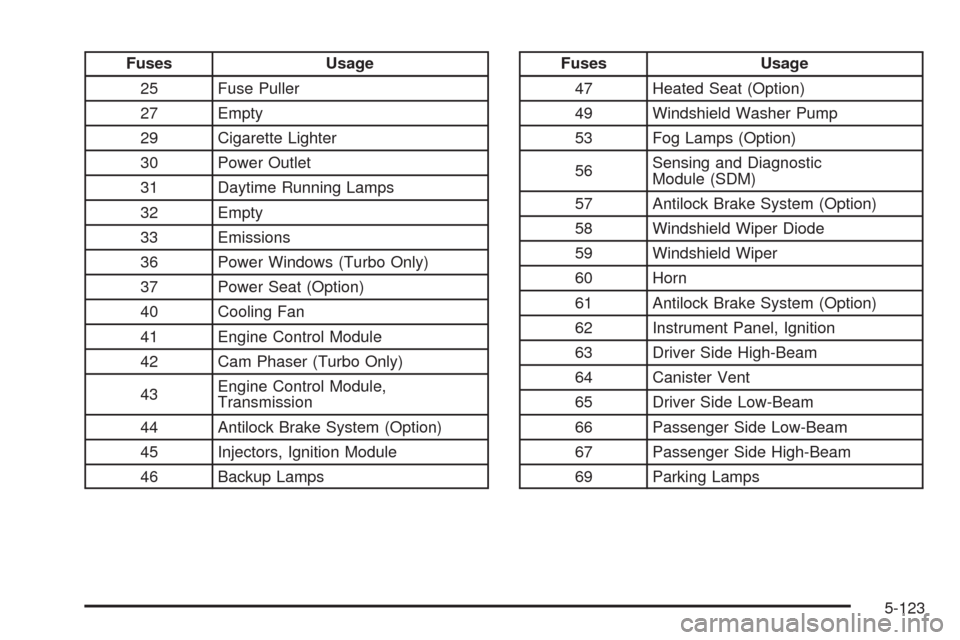
Fuses Usage
25 Fuse Puller
27 Empty
29 Cigarette Lighter
30 Power Outlet
31 Daytime Running Lamps
32 Empty
33 Emissions
36 Power Windows (Turbo Only)
37 Power Seat (Option)
40 Cooling Fan
41 Engine Control Module
42 Cam Phaser (Turbo Only)
43Engine Control Module,
Transmission
44 Antilock Brake System (Option)
45 Injectors, Ignition Module
46 Backup LampsFuses Usage
47 Heated Seat (Option)
49 Windshield Washer Pump
53 Fog Lamps (Option)
56Sensing and Diagnostic
Module (SDM)
57 Antilock Brake System (Option)
58 Windshield Wiper Diode
59 Windshield Wiper
60 Horn
61 Antilock Brake System (Option)
62 Instrument Panel, Ignition
63 Driver Side High-Beam
64 Canister Vent
65 Driver Side Low-Beam
66 Passenger Side Low-Beam
67 Passenger Side High-Beam
69 Parking Lamps
5-123
Page 417 of 430
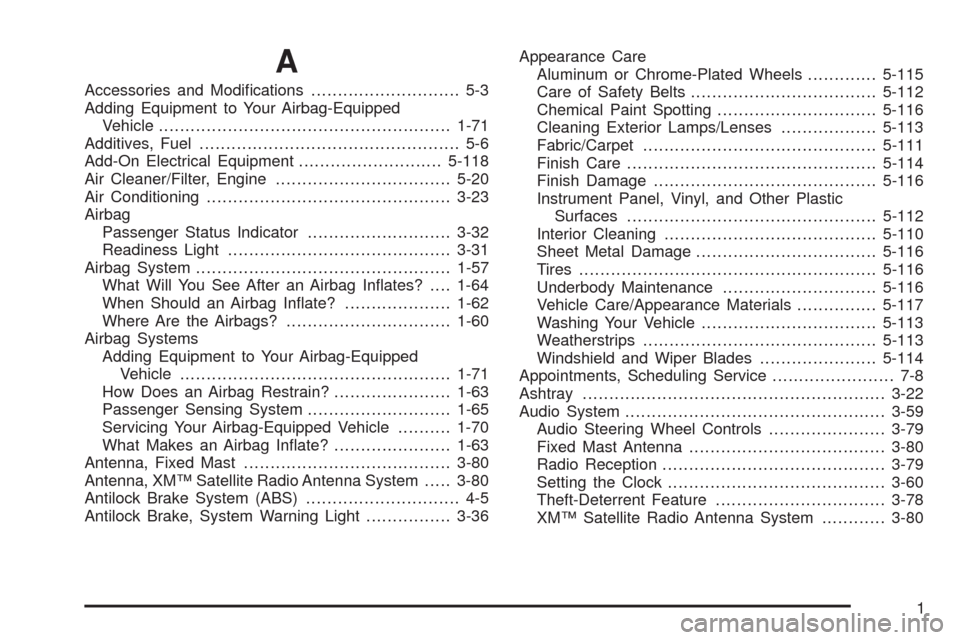
A
Accessories and Modi�cations............................ 5-3
Adding Equipment to Your Airbag-Equipped
Vehicle.......................................................1-71
Additives, Fuel................................................. 5-6
Add-On Electrical Equipment...........................5-118
Air Cleaner/Filter, Engine.................................5-20
Air Conditioning..............................................3-23
Airbag
Passenger Status Indicator...........................3-32
Readiness Light..........................................3-31
Airbag System................................................1-57
What Will You See After an Airbag In�ates?....1-64
When Should an Airbag In�ate?....................1-62
Where Are the Airbags?...............................1-60
Airbag Systems
Adding Equipment to Your Airbag-Equipped
Vehicle...................................................1-71
How Does an Airbag Restrain?......................1-63
Passenger Sensing System...........................1-65
Servicing Your Airbag-Equipped Vehicle..........1-70
What Makes an Airbag In�ate?......................1-63
Antenna, Fixed Mast.......................................3-80
Antenna, XM™ Satellite Radio Antenna System.....3-80
Antilock Brake System (ABS)............................. 4-5
Antilock Brake, System Warning Light................3-36Appearance Care
Aluminum or Chrome-Plated Wheels.............5-115
Care of Safety Belts...................................5-112
Chemical Paint Spotting..............................5-116
Cleaning Exterior Lamps/Lenses..................5-113
Fabric/Carpet............................................5-111
Finish Care...............................................5-114
Finish Damage..........................................5-116
Instrument Panel, Vinyl, and Other Plastic
Surfaces...............................................5-112
Interior Cleaning........................................5-110
Sheet Metal Damage..................................5-116
Tires........................................................5-116
Underbody Maintenance.............................
5-116
Vehicle Care/Appearance Materials...............5-117
Washing Your Vehicle.................................5-113
Weatherstrips............................................5-113
Windshield and Wiper Blades......................5-114
Appointments, Scheduling Service....................... 7-8
Ashtray.........................................................3-22
Audio System.................................................3-59
Audio Steering Wheel Controls......................3-79
Fixed Mast Antenna.....................................3-80
Radio Reception..........................................3-79
Setting the Clock.........................................3-60
Theft-Deterrent Feature................................3-78
XM™ Satellite Radio Antenna System............3-80
1
Page 419 of 430
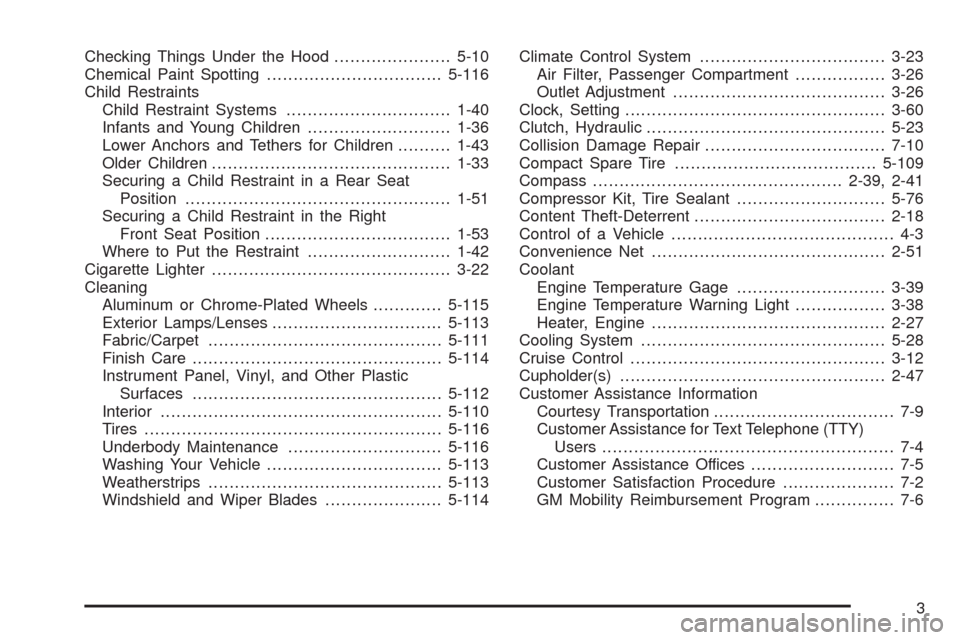
Checking Things Under the Hood......................5-10
Chemical Paint Spotting.................................5-116
Child Restraints
Child Restraint Systems...............................1-40
Infants and Young Children...........................1-36
Lower Anchors and Tethers for Children..........1-43
Older Children.............................................1-33
Securing a Child Restraint in a Rear Seat
Position..................................................1-51
Securing a Child Restraint in the Right
Front Seat Position...................................1-53
Where to Put the Restraint...........................1-42
Cigarette Lighter.............................................3-22
Cleaning
Aluminum or Chrome-Plated Wheels.............5-115
Exterior Lamps/Lenses................................5-113
Fabric/Carpet............................................5-111
Finish Care...............................................5-114
Instrument Panel, Vinyl, and Other Plastic
Surfaces...............................................5-112
Interior.....................................................5-110
Tires........................................................5-116
Underbody Maintenance.............................5-116
Washing Your Vehicle.................................5-113
Weatherstrips............................................5-113
Windshield and Wiper Blades......................5-114Climate Control System...................................3-23
Air Filter, Passenger Compartment.................3-26
Outlet Adjustment........................................3-26
Clock, Setting.................................................3-60
Clutch, Hydraulic.............................................5-23
Collision Damage Repair..................................7-10
Compact Spare Tire......................................5-109
Compass...............................................2-39, 2-41
Compressor Kit, Tire Sealant............................5-76
Content Theft-Deterrent....................................2-18
Control of a Vehicle.......................................... 4-3
Convenience Net
............................................2-51
Coolant
Engine Temperature Gage............................3-39
Engine Temperature Warning Light.................3-38
Heater, Engine............................................2-27
Cooling System..............................................5-28
Cruise Control................................................3-12
Cupholder(s)..................................................2-47
Customer Assistance Information
Courtesy Transportation.................................. 7-9
Customer Assistance for Text Telephone (TTY)
Users....................................................... 7-4
Customer Assistance Offices........................... 7-5
Customer Satisfaction Procedure..................... 7-2
GM Mobility Reimbursement Program............... 7-6
3
Page 426 of 430
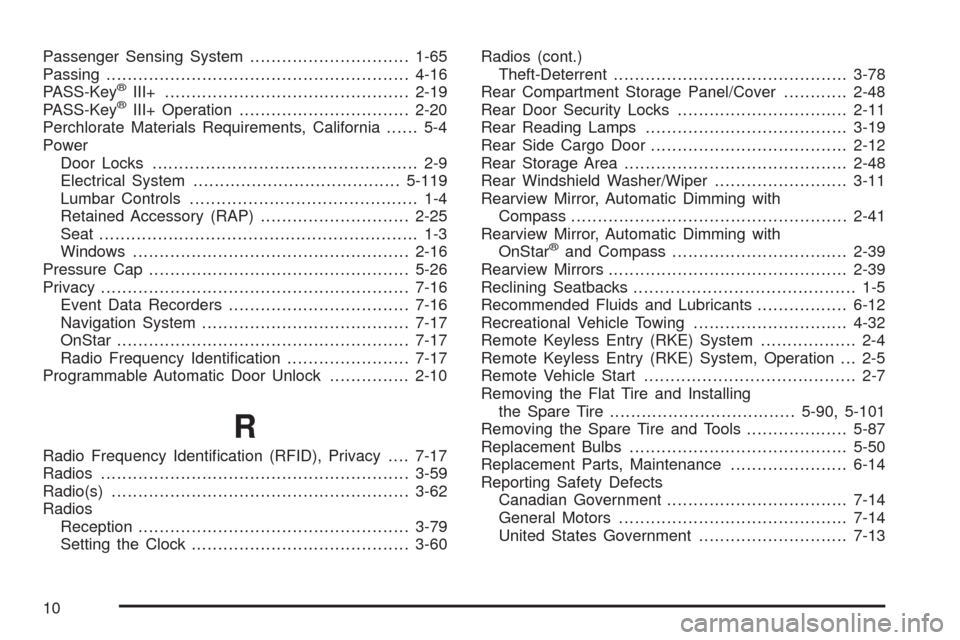
Passenger Sensing System..............................1-65
Passing.........................................................4-16
PASS-Key
®III+..............................................2-19
PASS-Key®III+ Operation................................2-20
Perchlorate Materials Requirements, California...... 5-4
Power
Door Locks.................................................. 2-9
Electrical System.......................................5-119
Lumbar Controls........................................... 1-4
Retained Accessory (RAP)............................2-25
Seat............................................................ 1-3
Windows....................................................2-16
Pressure Cap.................................................5-26
Privacy..........................................................7-16
Event Data Recorders..................................7-16
Navigation System.......................................7-17
OnStar.......................................................7-17
Radio Frequency Identi�cation.......................7-17
Programmable Automatic Door Unlock...............2-10
R
Radio Frequency Identi�cation (RFID), Privacy....7-17
Radios..........................................................3-59
Radio(s)........................................................3-62
Radios
Reception...................................................3-79
Setting the Clock.........................................3-60Radios (cont.)
Theft-Deterrent............................................3-78
Rear Compartment Storage Panel/Cover............2-48
Rear Door Security Locks................................2-11
Rear Reading Lamps......................................3-19
Rear Side Cargo Door.....................................2-12
Rear Storage Area..........................................2-48
Rear Windshield Washer/Wiper.........................3-11
Rearview Mirror, Automatic Dimming with
Compass....................................................2-41
Rearview Mirror, Automatic Dimming with
OnStar
®and Compass.................................2-39
Rearview Mirrors.............................................2-39
Reclining Seatbacks.......................................... 1-5
Recommended Fluids and Lubricants.................6-12
Recreational Vehicle Towing.............................4-32
Remote Keyless Entry (RKE) System.................. 2-4
Remote Keyless Entry (RKE) System, Operation . . . 2-5
Remote Vehicle Start........................................ 2-7
Removing the Flat Tire and Installing
the Spare Tire...................................5-90, 5-101
Removing the Spare Tire and Tools...................5-87
Replacement Bulbs.........................................5-50
Replacement Parts, Maintenance......................6-14
Reporting Safety Defects
Canadian Government..................................7-14
General Motors...........................................7-14
United States Government............................7-13
10
Page 428 of 430
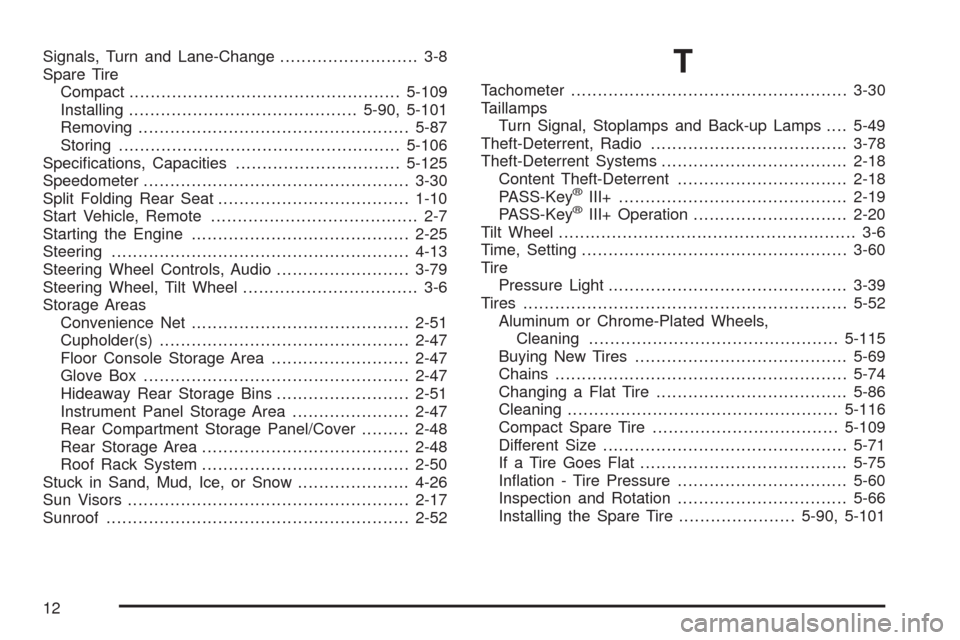
Signals, Turn and Lane-Change.......................... 3-8
Spare Tire
Compact...................................................5-109
Installing...........................................5-90, 5-101
Removing...................................................5-87
Storing.....................................................5-106
Speci�cations, Capacities...............................5-125
Speedometer..................................................3-30
Split Folding Rear Seat....................................1-10
Start Vehicle, Remote....................................... 2-7
Starting the Engine.........................................2-25
Steering........................................................4-13
Steering Wheel Controls, Audio.........................3-79
Steering Wheel, Tilt Wheel................................. 3-6
Storage Areas
Convenience Net.........................................2-51
Cupholder(s)...............................................2-47
Floor Console Storage Area..........................2-47
Glove Box..................................................2-47
Hideaway Rear Storage Bins.........................2-51
Instrument Panel Storage Area......................2-47
Rear Compartment Storage Panel/Cover.........2-48
Rear Storage Area.......................................2-48
Roof Rack System.......................................2-50
Stuck in Sand, Mud, Ice, or Snow.....................4-26
Sun Visors.....................................................2-17
Sunroof.........................................................2-52T
Tachometer....................................................3-30
Taillamps
Turn Signal, Stoplamps and Back-up Lamps....5-49
Theft-Deterrent, Radio.....................................3-78
Theft-Deterrent Systems...................................2-18
Content Theft-Deterrent................................2-18
PASS-Key
®III+...........................................2-19
PASS-Key®III+ Operation.............................2-20
Tilt Wheel........................................................ 3-6
Time, Setting..................................................3-60
Tire
Pressure Light.............................................3-39
Tires.............................................................5-52
Aluminum or Chrome-Plated Wheels,
Cleaning...............................................5-115
Buying New Tires........................................5-69
Chains.......................................................5-74
Changing a Flat Tire....................................5-86
Cleaning...................................................5-116
Compact Spare Tire...................................5-109
Different Size..............................................5-71
If a Tire Goes Flat.......................................5-75
In�ation - Tire Pressure................................5-60
Inspection and Rotation................................5-66
Installing the Spare Tire......................5-90, 5-101
12